Adhesiolysis
What Is Adhesiolysis?
Adhesiolysis is sometimes called epidural adhesiolysis or percutaneous epidural adhesiolysis. It is a treatment that is used to treat pain and scar tissue buildup along the spine. Scar tissue buildup can result in nerve root compression and cause severe pain. Additionally, chronic pain can result from irritated or inflamed nerve roots.
If nerve root inflammation is found to be the source of a patient’s pain, a needle is placed into the back in the lower posterior region, close to the buttock, and a steroid is injected via the needle to relieve the pain. Conversely, if scar tissue is found to be responsible for the pain, X-rays are utilized to carefully insert a slightly bigger needle into the back. Once the needle is in the proper position, a catheter is inserted through the needle and steroids and other medications are injected to destroy the scar tissue, thereby helping to reduce inflammation and pain. This minimally invasive procedure treats pain by blocking activity of the nerves in the damaged areas and by reducing fluid accumulation and infection occurrence.
How Is Adhesiolysis Performed?
Adhesiolysis is sometimes called the “Racz” procedure as it was founded by Dr. Gabor Racz. Patients will be given mild sedation prior to an epidural adhesiolysis procedure and will then be placed in a prone position. Adhesiolysis is performed under X-ray guidance that provides visualization of the spine. Contrast dye is injected to show the area that is affected by scar tissue buildup. The catheter is then inserted to administer the mixture of medications used to decrease scar tissue, inflammation, and pain. Occasionally, a balloon may be inserted to create more room around the compressed nerve. Additionally, the physician performing the procedure may utilize pulsed radiofrequency to encourage nerve regeneration if it is needed.
This procedure emphasizes needle and catheter placement in the posterior of the back as opposed to directly into the spine due to the potential adverse events that are associated with incorrect placement. Another benefit of this needle and catheter placement is that the distribution of medication to affected regions is improved.
There are rare cases where incorrect needle placement can cause perforating of the sac that encases the spinal cord in patients that have a spine that extends lower than expected. This form of elongation of the spine can be the result of anatomic variations, disease, or physical abnormalities. This type of adverse event can be avoided by utilizing magnetic resonance imaging (MRI) prior to the procedure to check for physical variations.
Conditions Related To Adhesiolysis
Various conditions can be treated with adhesiolysis, including:
- Spinal surgery syndrome
- Spinal stenosis
- Lumbar and cervical pain
- Leg pain
Spinal stenosis refers to a narrowing of the spinal canal that can result in spinal nerve compression. Symptoms of spinal stenosis include sensory and motor problems, muscle weakness, lumbar spinal pain, and leg pain. These symptoms may be caused by scar tissue and inflamed spinal nerves. Patients usually have an MRI prior to this procedure and again after it is completed. Following treatment with adhesiolysis, patients typically report less pain, with some patients reporting no pain at all.
Spinal surgery can lead to scar tissue development that can place pressure on spinal nerves, resulting in chronic pain in the lumbar spine. Some patients may also report leg pain with this condition. The first line of treatment for this condition is usually epidural steroid injections; however, adhesiolysis has been found to provide more effective and longer-lasting pain relief. This is because steroid injections may help to reduce inflammation but do not address the scar tissue.
The mixture of steroids and additional medications administered during an adhesiolysis procedure is what helps to remove the scar tissue. Therefore, while some patients suffering from spinal surgery syndrome may report some relief from an epidural steroid injection, others may not report any relief until an adhesiolysis procedure is performed.
Spinal surgery syndrome often causes leg and back pain; however, it is not always responsible for a patient’s pain. If scar tissue is found along the spine, though, it may be adding to a patient’s lumbar pain, leg pain, or even cervical pain. In these cases, adhesiolysis provides more pain relief than steroid injections alone.
Conclusion
Adhesiolysis is a minimally invasive procedure that is used for the treatment of pain and scar tissue buildup along the spine. A needle and catheter are inserted for the injection of steroids and additional medications into the lower posterior of the back to dissolve scar tissue that is causing the pain.
Pain associated with spinal surgery syndrome, spinal stenosis, leg pain, lumbar pain, and cervical pain can be successfully treated with adhesiolysis. These conditions are often treated with steroid injections initially. However, adhesiolysis is often necessary for patients to report a significant improvement in symptoms. Patients are encouraged to speak with their physician to determine if adhesiolysis would be an appropriate treatment option for their condition.
